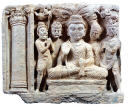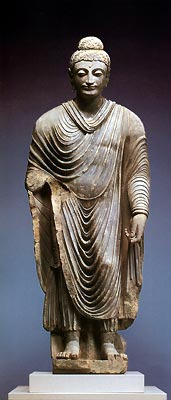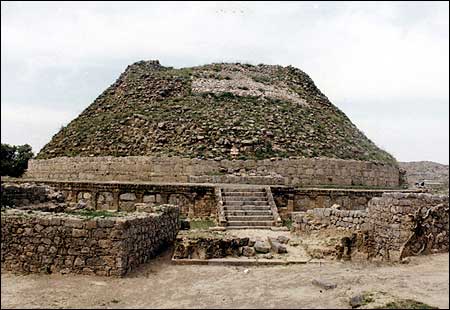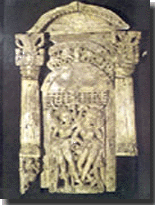Andrew Hall
Middle School Social Studies
Community Day Charter School, Lawrence, MA
Home
|
Gandharan
Art
|
 |
Adoration
of Buddha
Gandhara 3rd Century AD. Schist 38x28 cm |
 |
Gandhara Buddha Pakistan, Gandhara. Second half of the 2nd Century AD. Schist Height 250 cm. This form
of Buddha with striking features, regal robes, long toes, curled
hair, prominent Ushnisha and Urna along with elongated earlobes
set the standard for subsequent images of Buddha. These features
are seen throughout the Buddhist world even today. |
 |
The Lahore Museum, Gandhara 2nd or 3rd Century, Schist. This image of Buddha, depicting him as an asthetic is considered by some as the "Zenith of Gandharan Art". |
 |
Seated Buddha. 2nd or 3rd Century A.D. from Gandhara dark gray schist; 34 inches tall |
 |
Boddhisattva India 3rd century, Gandhara Schist |
Architecture:
 |
This majestic Buddha, carved into a mountainside at Bamiyan in the heart of the Hindu Kush mountains around the 3rd century, were once among Gandhara's great archeological treasures. Recently, the Taliban has destroyed several of these images. |
 |
Double headed Eagle stupa, Sirkap-Taxila. |
 |
Julian
Monastery, Taxila
|
 |
Dharamarajika
Stupa
|
Writing:
 |
This manuscript was found
in the Bhamiyan cave region in modern Afghanistan, purportedly from
the 5th century, on birch bark, and written in the Kharoshti script.
Found inside of a statue of Gandharan origin. |
 |
The texts from the preceding frame were unrolled, carefully placed in climate controlled frames and have been worked on by scholars in translating these early Buddhist texts. Translations are presently being published. |
 The
Rhinocerous Sutra (Translated)
The
Rhinocerous Sutra (Translated)
bhayea mitra padibhanavamta
bahosuda dhammadhara urada
(*anae dhammam vi)yigitsa prahae
ek(*o care khargavisanagapo')
One should cultivate
a friend who is intelligent,
learned, a master of the dharma, noble.
(*Having understood the dharma)
[and] abandoned doubt, (*one should wander) alone (*like the rhinoceros.)
sayi labhea nivago
sahayo
sardhacare sasovihari dhiro
(*abhibhuya) sarvani pariseani
carea ten' atamana svad(*ima')
If one should find a wise companion,
a well-behaved, strong fellow,
[then] (*overcoming) all dangers,
one should wander along with him, satisfied at heart, mindful.
no ya labhea nivag(*o)
sahayo
sardhacare sasovihari dhiro
(*raya va ratha) viyidam prahae
eko care khargavisanagap(*o')
If one should
not find a wise companion,
a well-behaved, strong fellow,
[then] (*like a king who) has abandoned (*the realm) [which he had] conquered,
one should wander alone like the rhinoceros.
Other Artistic Forms:
 |
Greek Coin Minted in Gandhara, with a head of Alexander the Great. |
 |
Princess at an entrance. Ivory carving. Begram,Kushan 2nd Century AD. Kabul Museum. |
 |
Frieze At the base of Stupa's, these panels represent the stories from the life of Buddha. He occupies a central position in these panels and can be easily recognised by his simple monastic robe, halo and vajrapani (thunder-bolt bearer). |
This site was created by .... at the NEH Summer Institute "Cultures and Religions of the Himalayan Region," held at the College of the Holy Cross, Summer 2004